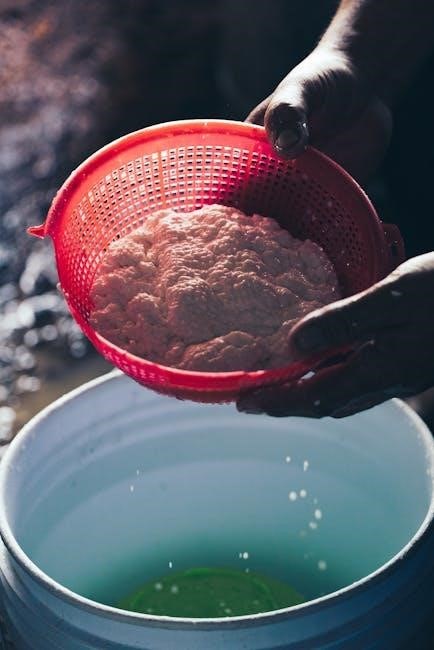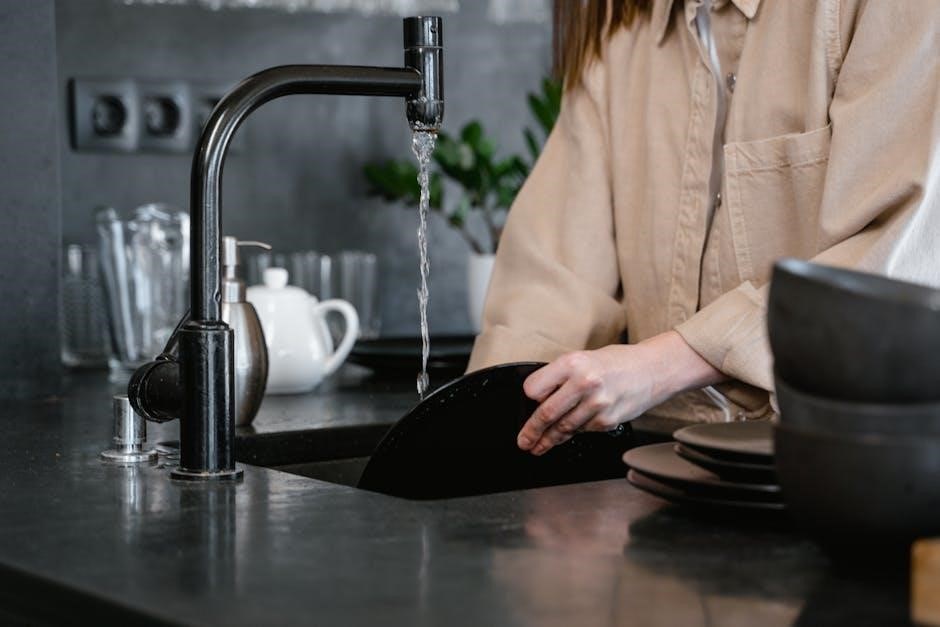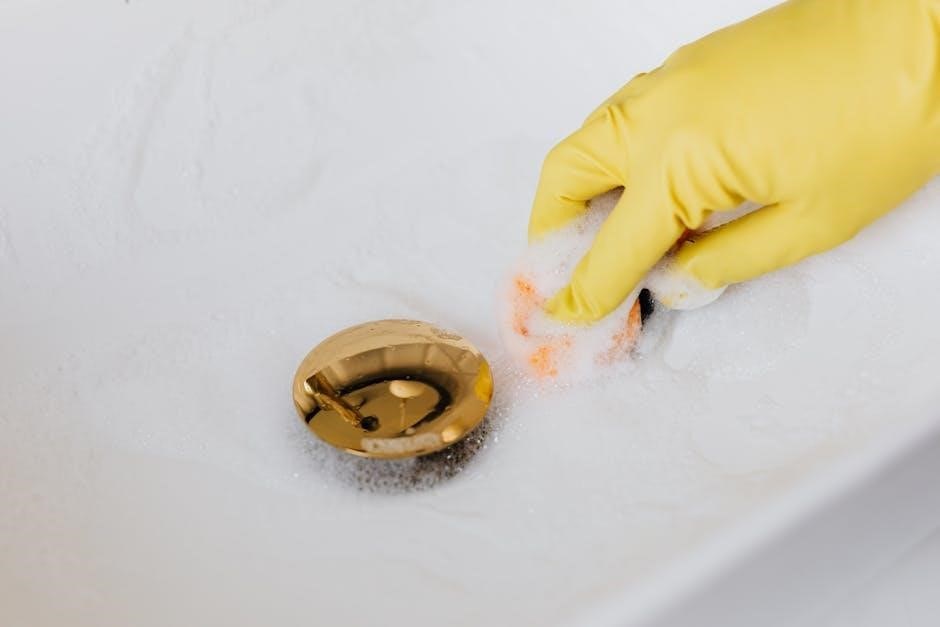The PleurX catheter system is a medical device designed to drain fluid from the pleural space, improving breathing comfort for patients with pleural effusion.
Proper drainage techniques are essential to ensure safety and effectiveness, minimizing risks of complications like infection or pulmonary edema.
Following the instructions carefully helps maintain catheter function and overall patient well-being.
1.1 Overview of the PleurX Catheter System
The PleurX catheter system is a thin, flexible tube placed in the chest or abdomen to drain excess fluid from the pleural space or peritoneal cavity.
It is designed for home use, allowing patients to manage fluid buildup independently, reducing the need for hospital visits.
The system includes a vacuum bottle for drainage and a catheter with a valve and lockable access tip to prevent air entry and fluid leakage.
Regular use of the PleurX system can improve breathing comfort and reduce symptoms associated with fluid retention.
Proper training and adherence to instructions are crucial to ensure safe and effective drainage, minimizing the risk of complications.
1.2 Importance of Following Proper Drainage Procedures
Following proper drainage procedures is critical to ensure safe and effective fluid removal using the PleurX catheter system.
Improper techniques can lead to complications such as infection, pneumothorax, or catheter damage, which may require medical intervention.
Adhering to instructions helps maintain catheter function, prevents air entry, and avoids fluid leakage, ensuring patient safety and comfort.
Proper drainage also minimizes the risk of re-expansion pulmonary edema and hypotension, which can occur if excessive fluid is drained too quickly.
By following guidelines, patients can effectively manage their condition and maintain independence while reducing the need for hospital visits.

Preparation for Drainage
Gather supplies, clean the catheter site, and position yourself comfortably to ensure safe and effective drainage, following proper hygiene and preparation steps outlined in the guidelines.
2.1 Gathering Necessary Supplies
To prepare for drainage, gather all essential supplies, including the PleurX drainage kit, vacuum bottle, catheter valve, alcohol pads, gloves, and a gown.
- Ensure the drainage kit is sterile and unexpired.
- Have a trash bag ready for disposing of used materials.
- Prepare a clean, flat surface for organizing supplies.
- Keep the catheter valve and access tip clean to prevent contamination.
Having all items ready ensures a smooth and safe drainage process.
2.2 Cleaning and Sterilizing the Area
Thoroughly clean the catheter site with antiseptic solution to minimize infection risk.
- Use alcohol pads to wipe the catheter valve and access tip.
- Allow the area to air dry to ensure proper sterilization.
- Wear gloves to maintain asepsis during the process.
- Ensure the surrounding skin is free from dirt or oils.
Proper cleaning and sterilization are crucial for preventing infections and ensuring safe drainage.
2.3 Positioning Yourself for Drainage
Position yourself comfortably, either sitting or standing, with the catheter below chest level to facilitate fluid flow.
- Ensure the catheter is not kinked or bent, as this may obstruct drainage.
- Place the vacuum bottle on a stable surface to prevent accidental spills.
- Keep the drainage line straight and avoid twisting to maintain proper function.
- Relax and remain still during the process to ensure smooth fluid extraction.
Proper positioning enhances the efficiency and safety of the drainage procedure.

Step-by-Step Drainage Process
The step-by-step drainage process involves connecting the catheter to a vacuum bottle, initiating fluid flow, and monitoring the process to ensure safe and effective drainage at home, improving breathing comfort.
3.1 Connecting the Drainage Bottle
To connect the drainage bottle, ensure the catheter valve is clean. Attach the drainage line to the valve, twisting until it clicks securely. Open the clamp on the vacuum bottle slowly to initiate suction. Keep the bottle below chest level to facilitate smooth fluid flow. Always maintain sterility to prevent infection and ensure proper function. Follow these steps carefully to ensure safe and effective drainage. Proper connection is crucial for the system to work correctly and prevent complications. Always refer to the provided instructions for detailed guidance. This step is essential for successful fluid drainage using the PleurX system.
3.2 Attaching the Catheter to the Vacuum Bottle
Attach the catheter to the vacuum bottle by inserting the access tip into the bottle’s port. Ensure it clicks securely to establish a proper seal. Once connected, open the white slide clamp on the bottle to allow fluid to flow into the vacuum container. Monitor the flow and stop if resistance is felt or if 1,000 mL has been drained. Always maintain a clean environment to prevent contamination. Proper attachment ensures effective drainage and minimizes the risk of complications. Follow the manufacturer’s guidelines for secure connection to maintain suction and system integrity.
3.3 Initiating Fluid Drainage
To initiate fluid drainage, connect the catheter to the vacuum bottle and ensure a secure seal with a click. Open the white slide clamp to allow fluid to flow into the bottle. Drainage typically begins within 10-15 minutes. Stop if resistance is felt or if 1,000 mL has been drained. Monitor the flow and ensure the vacuum indicator rises to confirm proper suction; Always follow the recommended volume limits to avoid discomfort or complications. Keep the area clean to prevent infection and ensure smooth operation of the PleurX system.
3.4 Monitoring the Drainage Process
During drainage, observe the fluid flow and volume closely. Ensure the vacuum indicator rises to confirm suction is active. Stop immediately if pain occurs or resistance is felt. Monitor for signs of complications, such as shortness of breath or dizziness. Track the amount and appearance of fluid, noting any changes in color or consistency. Keep a log of drainage volumes for medical follow-ups. Ensure the system remains clean and secure to prevent infection. Stop drainage once the recommended limit is reached, typically 1,000 mL for pleural drainage, to avoid complications like hypotension or pulmonary edema.
3.5 Completing the Drainage Procedure
Once drainage is complete, secure the catheter by placing a new cap on the valve and twisting until it clicks. Clean the catheter site with an alcohol pad and discard any used supplies. Empty the drainage bottle into the toilet and seal it in a plastic bag for disposal. Record the total fluid drained, its color, and consistency in your log. Ensure the catheter is properly secured under dressing to prevent dislodgement. If any issues arise, such as air entry or blockages, address them promptly to maintain system integrity and patient safety.
Post-Drainage Care
After drainage, secure the catheter with a new cap and clean the site with an alcohol pad. Dispose of used supplies properly and monitor for any complications.
4.1 Securing the Catheter
After completing the drainage, place a new cap on the catheter valve and twist it until it clicks into a locked position. This ensures the valve is secure and prevents any leakage. Use a foam catheter pad to cushion the catheter, then wind it gently on top of the pad. Cover the area with gauze pads and apply a self-adhesive dressing to protect the site. This step is crucial for maintaining the integrity of the catheter and preventing dislodgement or infection.
4.2 Cleaning the Catheter Site
Clean the catheter site with an alcohol pad to prevent infection. Gently wipe the area around the catheter and valve, ensuring no residue remains. Allow the area to air dry before securing the dressing. This step helps maintain a sterile environment and reduces the risk of bacterial growth.
Clean the site daily or before and after each drainage session. Inspect for redness, swelling, or drainage, and report any unusual signs to your healthcare provider immediately.
4.3 Disposing of Used Supplies
After drainage, dispose of used supplies properly to maintain hygiene and safety. Empty the drainage bottle into the toilet and seal it in a plastic bag before discarding. Clean or disposable gloves should be worn during this process to prevent contact with bodily fluids.
Dispose of any used alcohol pads, gauze, or other materials in a sealed plastic bag. Ensure all sharps, such as needles, are placed in a puncture-proof container if used. Follow local regulations for medical waste disposal to protect the environment and public health.

Documentation and Follow-Up
Record the amount and color of drained fluid after each session. Schedule regular check-ups with your healthcare provider to monitor progress and address concerns. Report any unusual symptoms promptly for timely intervention.
5.1 Recording Drainage Amount and Fluid Characteristics
Accurate documentation of drainage is crucial for monitoring progress and ensuring safe catheter use. After each drainage session, record the amount of fluid removed, noting the exact volume in milliliters. Also, document the fluid’s color, clarity, and consistency, as these characteristics can indicate potential issues. Use a log provided by your healthcare provider or maintain a personal record book. Track the date, time, and any unusual observations. This data helps healthcare providers assess your condition and adjust treatment plans. Remember to bring your log to all follow-up appointments for comprehensive care management.
5.2 Scheduling Regular Medical Check-Ups
Regular medical check-ups are essential for monitoring your condition and ensuring proper catheter function. Schedule follow-up appointments as directed by your healthcare provider to assess your overall health and address any concerns. These visits allow your doctor to evaluate the catheter site for signs of infection or complications. Skipping appointments may lead to undetected issues, potentially causing serious health risks. Bring your drainage log to each visit, as it provides valuable insights into your progress. Regular check-ups help maintain your well-being and ensure the catheter continues to function effectively. Stay proactive in your care to avoid complications and promote long-term health.
5.3 Reporting Any Unusual Symptoms
Immediately report any unusual symptoms to your healthcare provider, such as chest pain, difficulty breathing, fever, or redness/swelling around the catheter site; These could indicate complications like infection or pneumothorax. Monitor for changes in fluid color, consistency, or drainage patterns. Unexplained fatigue, dizziness, or shortness of breath should also be reported. Early detection of issues ensures timely intervention and prevents severe complications. Keep a log of symptoms and share it with your doctor during check-ups. Your health and safety depend on prompt communication with your medical team.

Potential Risks and Complications
Infection, pneumothorax, and pulmonary edema are potential risks. Strict adherence to instructions can prevent these complications. Awareness and proper technique are crucial for safe drainage.
6.1 Infection Prevention Measures
Strict aseptic technique is crucial to prevent infections. Always clean the catheter site with alcohol pads before and after use. Ensure the catheter valve and access tip remain sterile. Avoid touching the catheter unnecessarily to minimize germ exposure. Use antibacterial ointment around the insertion site if recommended by your healthcare provider. Secure the catheter to prevent movement, which can irritate the skin and increase infection risk. Regularly inspect the site for redness, swelling, or pus, and report any signs of infection promptly. Proper hygiene and adherence to these measures significantly reduce the risk of complications.
6.2 Managing Pain and Discomfort
Pain and discomfort during drainage can be managed with prescribed pain medications or over-the-counter options, as directed by your healthcare provider. Applying a topical anesthetic cream to the catheter site before drainage may reduce discomfort. Ensure the catheter is properly secured to avoid pulling or irritation. Breathing exercises, such as deep breathing, can help relax the chest muscles and reduce tension. If pain persists or worsens, notify your healthcare provider immediately to rule out complications. Regular follow-ups and adjustments to the catheter can also help minimize discomfort and improve overall drainage experience.
6.3 Recognizing Signs of Complications
Monitor for signs of complications such as chest pain, shortness of breath, dizziness, or fever, which may indicate issues like pneumothorax or infection. If fluid drainage is bloody, cloudy, or foul-smelling, contact your healthcare provider immediately. Look for redness, swelling, or pus around the catheter site, as these are signs of infection. If you experience severe pain or difficulty breathing, seek medical attention promptly. Unusual sounds or resistance during drainage may signal a blockage or catheter malfunction. Always report any unexpected symptoms to your healthcare provider for timely intervention and to prevent serious complications.

Catheter Maintenance
Regular catheter maintenance ensures proper function. Clean the valve with alcohol pads, check for leaks or blockages, and store the catheter securely when not in use.
7.1 Cleaning the Catheter Valve
Cleaning the catheter valve is crucial for maintaining proper function and preventing infection. Use alcohol pads to wipe the valve and access tip thoroughly. Ensure the area is dry before reattaching any components. Regular cleaning prevents bacterial growth and ensures the valve operates smoothly. Always follow the manufacturer’s guidelines for cleaning products and techniques; Proper maintenance extends the life of the catheter and safeguards patient health.
7.2 Checking for Proper Catheter Function
Regularly inspect the catheter and valve for proper function. Ensure the valve is clean and free from blockages. Check the drainage line for kinks or leaks, as these can disrupt fluid flow. Verify that the vacuum bottle is securely connected and functioning correctly. Look for signs of wear or damage on the catheter and connections. Proper function ensures effective drainage and prevents complications. Always refer to the manufacturer’s guidelines for specific inspection procedures. Maintaining catheter integrity is vital for patient safety and optimal drainage outcomes.
7.3 Storing the Catheter When Not in Use
When not in use, store the PleurX catheter in a clean, dry environment to prevent contamination. Keep the catheter and valve covered with a protective cap to maintain sterility. Avoid exposing the catheter to extreme temperatures or direct sunlight. Ensure the catheter is coiled gently to prevent kinking or damage. Regularly inspect the catheter for signs of wear or damage before reuse. Always follow the manufacturer’s guidelines for storage to maintain the integrity of the catheter system. Proper storage ensures the catheter remains functional and ready for use when needed.

Troubleshooting Common Issues
Troubleshooting common issues with the PleurX catheter involves addressing blockages, leaks, or catheter dislodgement promptly to ensure proper function and patient safety.
8.1 Resolving Blockages in the Catheter
If a blockage occurs, check the catheter for kinks or twists that may restrict flow. Gently straighten or reposition the catheter as needed.
Flushing the catheter with sterile saline solution can help clear debris. Avoid using harsh materials, as they may damage the catheter.
If the blockage persists, consult your healthcare provider for professional assistance to prevent complications and ensure proper drainage.
8.2 Addressing Leaks or Air Entry
If a leak is detected, inspect all connections to ensure they are secure. Tighten any loose fittings and verify the integrity of the catheter and tubing.
If air enters the catheter, stop the drainage process immediately to prevent complications like pneumothorax. Consult your healthcare provider for guidance on resolving the issue.
Regularly inspect the system for signs of wear or damage to prevent future leaks or air entry, ensuring safe and effective drainage.
8.3 Dealing with Catheter Dislodgement
If the catheter becomes dislodged, stop drainage immediately to avoid complications. Inspect the catheter and surrounding area for any damage or misplacement.
Gently reposition the catheter if possible, ensuring it is secure and properly aligned. Monitor for signs of fluid leakage or air entry, and document any issues.
Contact your healthcare provider promptly for professional adjustment or replacement to maintain proper function and prevent further complications.
Consistently follow PleurX drain instructions to ensure safe and effective fluid management. Monitor drainage amounts and fluid characteristics, and seek medical advice if unusual symptoms arise. Maintain catheter hygiene and function, and always keep track of your drainage log for better health outcomes. Stay proactive in your care to enhance comfort and independence.
9.1 Summary of Key Drainage Steps
Always follow the provided instructions carefully to ensure safe and effective drainage. Connect the catheter to the vacuum bottle securely, avoiding air entry. Drain fluid gradually, never exceeding 1,000 mL from the chest or 2,000 mL from the abdomen at one time. Monitor the process closely and stop if discomfort occurs. Keep the catheter and surrounding area clean to prevent infection. Record the amount and appearance of drained fluid for medical reference. Store the catheter properly when not in use and seek medical advice if issues arise. Regular maintenance and logging are essential for optimal outcomes.
9.2 Encouraging Patient Independence
Patient independence is key to managing the PleurX catheter system effectively. Educate yourself on proper drainage techniques and maintenance to confidently handle the process at home. Keep a log of drainage amounts and fluid characteristics to track progress and share with healthcare providers. Regularly reviewing instructions and seeking clarification when needed fosters self-reliance. Encourage a routine for drainage and catheter care to ensure consistency and safety. Empower yourself by understanding the system’s operation and benefits, allowing you to take control of your health and reduce reliance on medical visits.
9.3 Accessing Additional Resources
For further guidance, patients can access instructional videos, downloadable PDF guides, and manufacturer support hotlines. These resources provide detailed step-by-step instructions and troubleshooting tips. Many healthcare providers offer additional training sessions or one-on-one consultations. Online forums and support groups can also offer shared experiences and advice from other patients. Always refer to the official PleurX website or consult with your healthcare provider for the most accurate and up-to-date information. Utilizing these resources ensures you feel confident and informed in managing your catheter and drainage process effectively.
